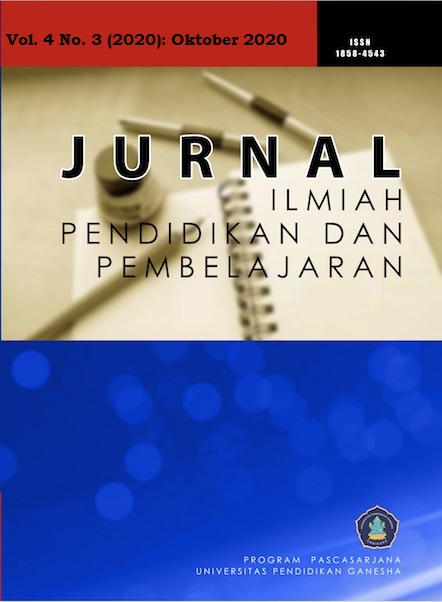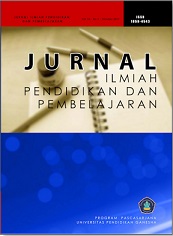Analisis Indikator Kegagalan Siswa dalam Menempuh Pendidikan di Sekolah
DOI:
https://doi.org/10.23887/jipp.v4i3.23989Abstract
The main purpose of this study is to comprehensively investigate / investigate, what and why the causes of student learning failures, because many aspects and causes so that failure is not only from the initial study, but also towards the end of the study. (study period ends). The method used in this study is a form of qualitative approach with a phenomenological model, which involves 10 ex(Drop out) students as participants / informants, two teacher and two parents (14 participants), from various backgrounds and origins of schools. After conducting research with approximately 3 months (12 weeks), the authors get five things that need to be addressed. and improved in various aspects to minimize the failure rate of students in research, are: Motivation, Condition, Intelligence, Economics and opportunities
Tujuan utama penelitian ini adalah untuk menyelidiki / menelaah secara komprehensif, apa dan mengapa penyebab kegagalan belajar siswa, karena banyak aspek dan penyebabnya sehingga kegagalan tidak hanya dari studi awal, tetapi juga menjelang akhir penelitian. (masa studi berakhir). Metode yang digunakan dalam penelitian ini adalah bentuk pendekatan kualitatif dengan model fenomenologis, yang melibatkan 10 mantan (Drop out) siswa sebagai peserta / informan,dua orang Guru dan dua orangtua siswa(jumlah 14 orang) dari berbagai latar belakang dan asal sekolah. Setelah melakukan penelitian dengan sekitar 3 bulan (12 minggu), penulis mendapatkan lima hal yang perlu dibenahi. dan ditingkatkan dalam berbagai aspek untuk meminimalkan tingkat kegagalan siswa dalam penelitian, adalah: Motivasi, Kondisi, Kecerdasan, Ekonomi dan peluang
References
Burke, P. Y. (2017). Graduate School. In Technical Career Survival Handbook. https://doi.org/10.1016/b978-0-12-809372-6.00008-6
Choudhary AI, L. A. (2015). Economic Effects of Student Dropouts: A Comparative Study. Journal of Global Economics. https://doi.org/10.4172/2375-4389.1000137
Creswell, J. W. (2009). Research Design: Qualitative, Quantitative and Mixed Approaches (3rd Edition). In Research Design: Qualitative, Quantitative, and Mixed Methods Approaches. https://doi.org/10.2307/1523157
Dağ, N., & Arslantaş, H. A. (2015). Reasons preventing teachers from acting within the framework of ethical principles. International Journal of Instruction. https://doi.org/10.12973/iji.2015.823a
de Ridder, K. A. A., Pape, K., Johnsen, R., Holmen, T. L., Westin, S., & Bjørngaard, J. H. (2013). Adolescent Health and High School Dropout: A Prospective Cohort Study of 9000 Norwegian Adolescents (The Young-HUNT). PLoS ONE. https://doi.org/10.1371/journal.pone.0074954
Giavrimis, P., & Papanis, E. (2008). Sociological Dimensions of School Failure: The Views of Educators and Students of Educational Scchools. The Journal of International Social Research,⅕ Fall.
Kementerian Pendidikan dan Kebudayaan » Republik Indonesia. (2015). Target Kemendikbud Dalam Pengembangan Pendidikan dan Kebudayaan Tahun 2017. Kementerian Pendidikan Dan Kebudayaan.
Khong, H. K., Hassan, N. H., & Ramli, N. (2017). Motivation and gender differences in learning Spanish as a foreign language in a Malaysian Technical University. Malaysian Journal of Learning and Instruction. https://doi.org/10.32890/mjli2017.14.2.3
Lee, P. L., & Pang, V. (2013). Motivational factors in continuing education an academic achievement of adult learners. Malaysian Journal of Learning and Instruction.
Leonard-Barton, D. (1990). A Dual Methodology for Case Studies: Synergistic Use of a Longitudinal Single Site with Replicated Multiple Sites. Organization Science. https://doi.org/10.1287/orsc.1.3.248
Miles, M. A. (1994). Miles and Huberman (1994)- Chapter 4.pdf. In Qualitative Data Analysis: An Expanded Sourcebook.
Notarius, C. I., & Levenson, R. W. (1979). Expressive tendencies and physiological response to stress. Journal of Personality and Social Psychology. https://doi.org/10.1037/0022-3514.37.7.1204
Sugiyono, S. (2014). Metode penelitian pendidikan pendekatan kuantitatif.pdf. In Metode Penelitian Pendidikan Pendekatan Kuantitatif, Kualitatif Dan R&D.
Quensel, S., McArdle, P., Brinkley, A., & Wiegersma, A. (2002). Broken home or drug using peers: “Significant relations”? In Journal of Drug Issues. https://doi.org/10.1177/002204260203200209
Saidi, S. (2016). Perbedaan Prestasi Belajar Siswa Yang Mengikuti Bimbingan Belajar dan Yang Tidak Mengikuti Bimbingan Belajar Siswa Kelas XII IPS Mata Pelajaran Ekonomi SMA Sinar Pancasila Balikpapan. Jurnal Intelegensia. https://doi.org/10.1017/CBO9781107415324.004
Salame, I. I., & Nazir, S. (2019). The Impact of Supplemental Instruction on the Performance and Attitudes of General Chemistry Students. International Journal of Chemistry Education Research. https://doi.org/10.20885/ijcer.vol3.iss2.art1
Sukiasih, M. (2018). Peningkatan Prestasi Belajar Bahasa Indonesia Dalam Menulis Puisi Pada Siswa Melalui Implementasi Model Pembelajaran Kooperatif Tipe Tgt. Jurnal Imiah Pendidikan Dan Pembelajaran. https://doi.org/10.23887/jipp.v2i3.16230
Sutopo, AH; Arief, A. (2010). Terampil Mengolah Data KUalitatif dengan NVIVO. In Penerbit Prenada Media Group.
Taufik, A. (2019). Perspektif Tentang Perkembangan Sistem Pembelajaran Jarak Jauh Di Kabupaten Kutai Kartanegara Kalimantan Timur. Jurnal Pendidikan&Konseptual, 3(2), 88–98. https://doi.org/DOI:http://doi.org/10.28926/riset_konseptual.v2i4.111
Vander Stoep, A., Weiss, N. S., Kuo, E. S., Cheney, D., & Cohen, P. (2003). What Proportion of Failure to Complete Secondary School in the US Population Is Attributable to Adolescent Psychiatric Disorder? Journal of Behavioral Health Services and Research.
Downloads
Published
How to Cite
Issue
Section
License
Authors who publish with the Jurnal Ilmiah Pendidikan dan Pembelajaran (JIPP) agree to the following terms:
- Authors retain copyright and grant the journal the right of first publication with the work simultaneously licensed under a Creative Commons Attribution License (CC BY-SA 4.0) that allows others to share the work with an acknowledgment of the work's authorship and initial publication in this journal.
- Authors are able to enter into separate, additional contractual arrangements for the non-exclusive distribution of the journal's published version of the work (e.g., post it to an institutional repository or publish it in a book), with an acknowledgment of its initial publication in this journal.
- Authors are permitted and encouraged to post their work online (e.g., in institutional repositories or on their website) prior to and during the submission process, as it can lead to productive exchanges, as well as earlier and greater citation of published work. (See The Effect of Open Access)










